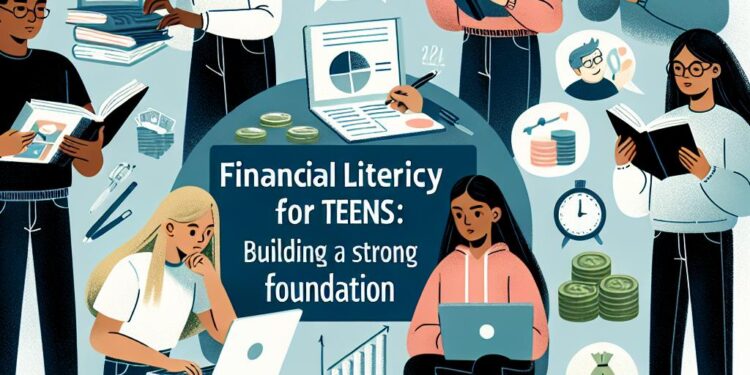Let’s get real for a moment: financial literacy isn’t just for adults. In fact, starting young with “Financial Literacy for Teens: Building a Strong Foundation” can be a game-changer in your financial planning and investment strategy. Why? Because when you understand and apply these concepts early on, you’re setting yourself up for a lifetime of financial security and potentially significant wealth accumulation. Many people mistakenly believe that finances are too complex for teens, or they chalk it up as ‘something to learn later.’ This blog is here to show you that financial know-how isn’t just accessible—it’s practical, actionable, and incredibly empowering for your future. Here, we’ll debunk those misconceptions with tips and strategies designed to guide young minds toward smarter financial decisions.
How Can Teens Achieve Financial Literacy?
Financial literacy for teens is all about understanding how money works and making informed decisions about managing it. Imagine it like learning to ride a bike. Initially, you might wobble, but practice builds confidence and skill. It’s the basis of financial knowledge, covering everything from budgeting to saving, investing, and understanding economic principles. Like learning the rules of a game before playing, mastering these concepts early can set the stage for a lifetime of financial health. You’ll know how to create a budget, save for future goals, and invest wisely for long-term growth. Think of financial literacy as a toolkit. The tools? Skills like calculating returns, assessing risk, and spotting economic trends. These help you make smarter decisions whether you’re saving pocket money, getting your first job, or planning long-term investments. Being financially literate also means you’re prepared for unexpected expenses and financial opportunities. How brilliant is that?Why Is Financial Literacy Crucial for Teens?
Understanding “Financial Literacy for Teens: Building a Strong Foundation” is crucial because it equips young people with the knowledge needed to make informed decisions about money throughout their lives. Teens who grasp financial concepts are more likely to handle challenges like budgeting, saving, and investing effectively. They gain insights into how money works, which enables them to plan for future expenses and manage debt wisely. This foundational knowledge fosters independence and prepares them to cope with economic changes. Ultimately, a strong financial foundation empowers teens to have a positive relationship with money, setting them on a path toward a stable and secure future.Financial Literacy for Teens: Building a Foundation
- Start with understanding the basics: Teens should kick things off by learning terminology like budget, savings, and investing. Schools and parents play a crucial role here. For instance, budgeting their weekly allowance teaches them about managing money.
- Create a simple budget: Encourage teens to track their income and expenses. They can use easy apps or a plain notebook. By seeing where their money goes, they’ll learn spending habits and identify saving opportunities.
- Open a savings account: Help them set up a bank account if they don’t already have one. It could be a joint account with a parent or a youth savings account, teaching them about interest rates and building good saving habits.
- Get familiar with investing: Introduce the idea of investing through platforms like kid-friendly investment apps. Investors and advisors can share insights on asset building and potential risks in an easy-to-understand way.
- Learn about financial regulations: Explain how regulators protect consumers and ensure fair practices. Understanding consumer rights builds trust in financial systems and empowers teens to navigate money decisions confidently.
Pros and Cons of Financial Literacy for Teens: Building Foundations
| Benefits | Risks/Disadvantages |
|---|---|
|
|
Practical Lessons for Teens: Cultivating Financial Skills for Success
- Schools: Many schools are incorporating programs like ‘Financial Literacy for Teens: Building a Strong Foundation’ into their curriculum to prepare students for real-world money management. This education empowers teenagers with basic understanding of finances that they can build upon as they grow.
- Parents: At home, parents use the program to introduce financial conversations early, creating a safe space for kids to ask questions and make informed financial decisions. The goal is to ensure financial discussions are frequent, relatable, and comprehensive.
- Community Centers: Community centers offer workshops using these resources to engage teens in interactive exercises, making learning about finance more practical and less intimidating. This often leads to a ripple effect, where teens teach their families what they’ve learned.
- Financial Institutions: Some banks and credit unions use these principles to involve young customers, fostering loyalty and encouraging good financial habits from a young age.
Financial Literacy for Teens: Essential Tips for a Strong Start
| Resource Type | Resource Name | Purpose |
|---|---|---|
| Book | “Rich Dad Poor Dad for Teens” by Robert T. Kiyosaki | Provides financial education lessons tailored specifically for teenagers. |
| YouTube Channel | The Money Guy Show | Offers engaging video content on personal finance and investment strategies for teens. |
| Online Course | Khan Academy: Personal Finance | A comprehensive online course covering basics of budgeting, saving, and investing. |
| Website | moneysense.co.uk | Features articles and resources focused on improving financial literacy among teenagers. |
| Expert Voice | Dave Ramsey | Renowned for teaching practical financial skills, catering to a younger audience. |
Mastering Finance for Modern Freelancers: Boost Your Wealth Wisely
- Teen Entrepreneurs: Teens interested in starting their own businesses will benefit from understanding money management to strategize for growth, handle profits, and manage business expenses effectively.
- University Goers: Those preparing for higher education will find it helpful for budgeting tuition, living expenses, and understanding student loans to avoid financial pitfalls during their studies.
- Investment-Interested Teens: Youngsters keen on exploring stock investing early can learn about risk and return, historical returns, and economic trends to make informed decisions and possibly grow wealth over time.
- Financially Curious Adolescents: Teens eager to understand how money works can build a solid base for future independence, setting them up for smart financial decisions in adulthood.
Future Trends in Teen Financial Literacy Education
– Embracing Technology: With advancements in apps and AI-driven platforms, young learners will have unprecedented access to financial tools that simplify budgeting, saving, and investing. These innovations make financial education more interactive and engaging.– Inclusive Financial Policies: Emerging policies focus on promoting financial literacy in schools, ensuring that teenagers grasp core concepts like compound interest early. Expect state support to bolster these initiatives.
– Sustainable Investment Awareness: As eco-friendly investments gain traction, teenagers will become more aware of responsible investing. They’ll learn to balance profitability with environmental consciousness—an essential skill in today’s market.
The future holds a wealth of opportunities for tech-savvy teens to grow financially literate, ensuring they’re prepared for the complexities of modern finance. While technology and policy are allies, engaging educational content will remain key to building their financial foundations. Brighter days are ahead!













